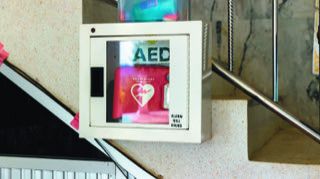You’ve seen the red boxes on walls in airport terminals and other public venues. They’re called automated external defibrillators, or AEDs, and even an untrained bystander can use them to shock a heart beating irregularly back into a normal rhythm when a person has gone into cardiac arrest and their heart has stopped pumping blood. They save about 1,700 human lives a year in the United States, including the life of football player Damar Hamlin last season. If an AED had not been available, he probably would not have made it off the field alive. Now researchers at the Tufts Cummings School of Veterinary Medicine have found that AEDs have the potential to save dogs’ lives, too.
In a groundbreaking study led by Tufts Your Dog editorial board member Elizabeth Rozanski, DVM, who is board-certified in emergency and critical care, AED pads were placed on the chests of 42 dogs cared for at the vet school’s Foster Hospital for Small Animals, nine of whom who had been receiving CPR during cardiac arrest. Dr. Rozanski and two veterinary cardiologists at Tufts found that the machines were able to conduct a proper electrocardiogram (EKG) on all the dogs. And in virtually all cases the AEDs could determine whether shocking the heart with defibrillation was necessary (the healthy dogs did not need it) and to what degree — in an average of 18 seconds. That was the case even though 89 percent of those dogs with heavy, long, or double haircoats needed to be clipped to get a readable EKG. (People with moderate to dense chest hair need to be clipped first, too.)
Practical implications
Dr. Rozanski says further research on AEDs for dogs would yield even more information. But although this is the first study on the subject, she comments that in addition to AEDs in public spaces where people congregate, they should also be in places that dogs congregate — namely veterinary practices, agility courses, dog shows, and other canine gathering spots. The machines could save a dog or a person. Average response time to a 9-1-1 call is 8 to 12 minutes, the Red Cross says, with the odds of survival decreasing about 10 percent for every minute of delay after cardiac arrest.





